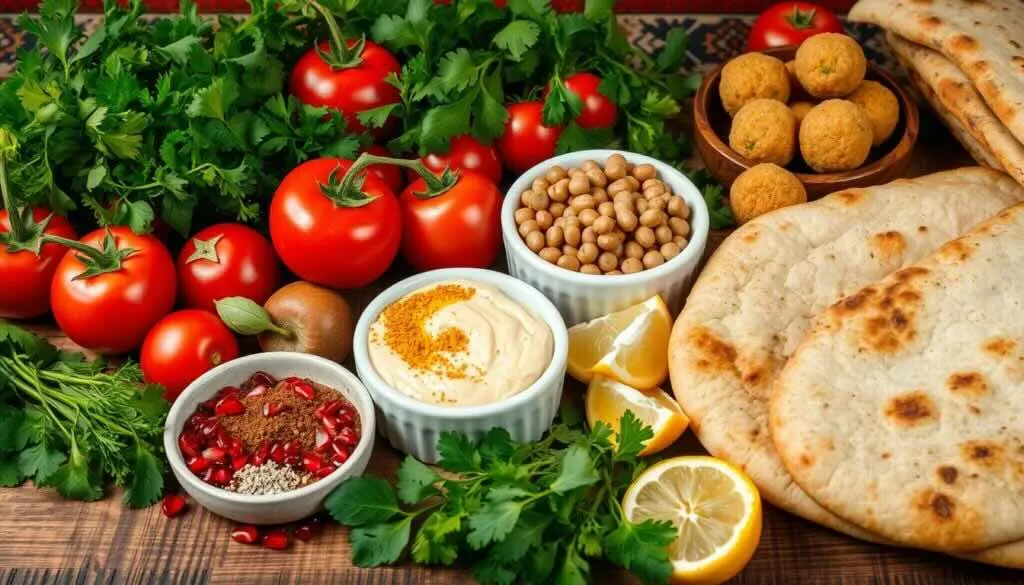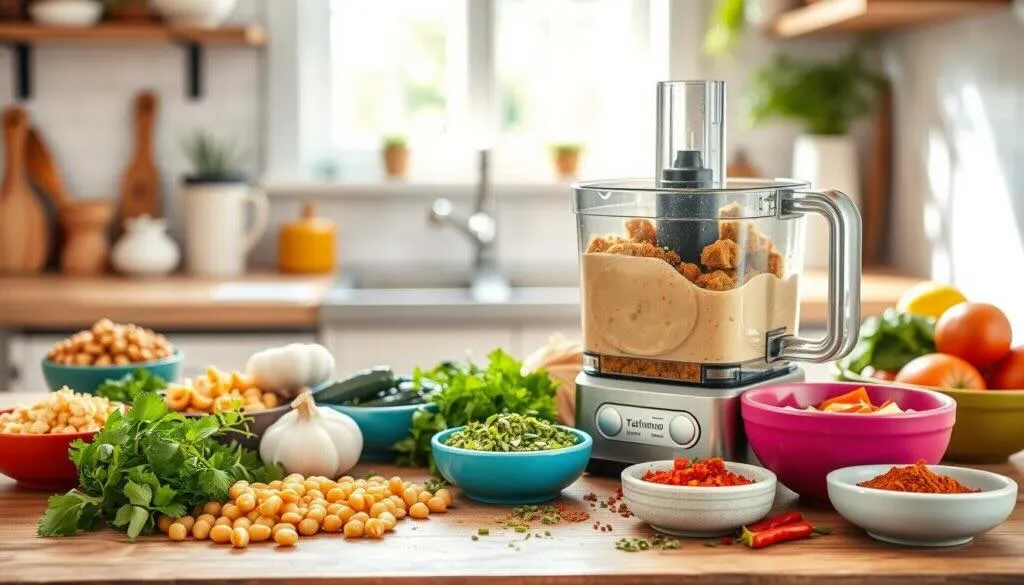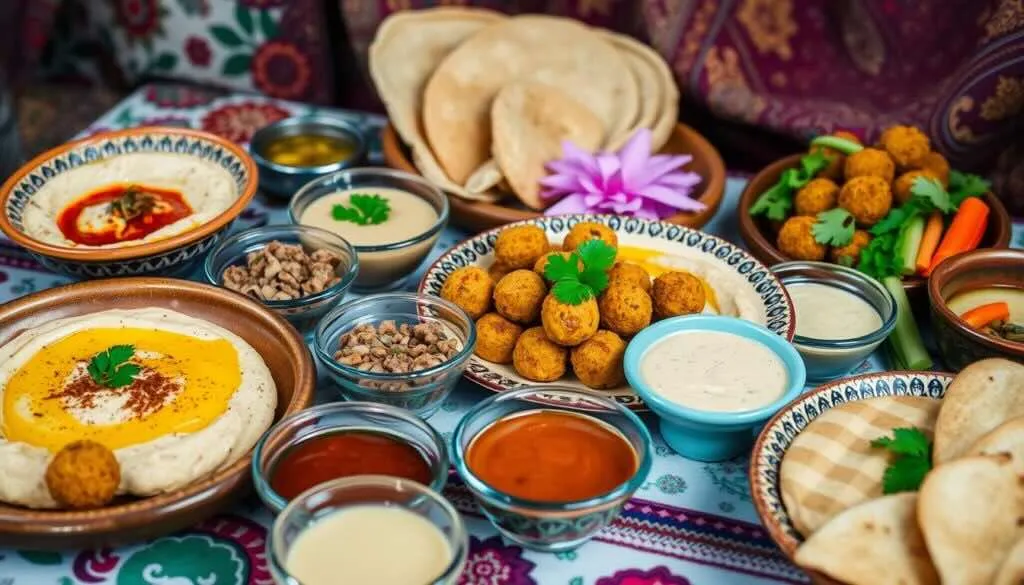Are you ready to turn your kitchen into a Middle Eastern paradise? Imagine making falafel hummus that takes you straight to Beirut’s lively streets.
Join us on a tasty trip through Middle Eastern cuisine. Every bite shares a story of tradition, flavor, and passion. Our 35 unique falafel hummus recipes will change your cooking game. They offer both classic and new ways to enjoy these dishes.
Falafel hummus is more than food; it’s a celebration of vegetarian delights for all. You can choose to fry or bake, and these recipes will add real Middle Eastern flavors to your cooking.
Table of Contents
Key Takeaways
- Discover 35 authentic and creative falafel hummus recipes
- Learn versatile cooking techniques from Middle Eastern cuisine
- Explore vegetarian-friendly and health-conscious meal options
- Master the art of preparing traditional and fusion dishes
- Unlock the secrets of perfect flavor combinations
Understanding Middle Eastern Cuisine
Middle Eastern cuisine is a colorful mix of flavors, traditions, and cooking skills from 18 countries. Exploring Mediterranean cuisine, you’ll find a world of falafel hummus and Middle Eastern ingredients. These ingredients share stories of culture, history, and community.

The region’s food scene is incredibly diverse. It combines ingredients and cooking methods perfected over centuries. Middle Eastern staples like chickpeas, tahini, olive oil, and spices are at the heart of many favorite dishes.
Origins of Mediterranean Flavors
Mediterranean cuisine has a rich history of trade, migration, and cultural exchange. Each area adds its own twist, creating a mix of tastes that show local traditions and influences.
- Chickpeas and sesame seeds as primary protein sources
- Olive oil as a fundamental cooking medium
- Spices like baharat and za’atar defining regional profiles
Essential Ingredients in Middle Eastern Cooking
Key ingredients in Middle Eastern cooking include:
- Chickpeas – crucial for falafel hummus
- Tahini – a sesame seed paste
- Fresh herbs like parsley and mint
- Lemon for bright, acidic notes
Cultural Significance of Traditional Dishes
“Food is our common ground, a universal experience.” – James Beard
Traditional dishes like falafel and hummus are more than food. They symbolize community, hospitality, and shared cultural heritage. These recipes bring people together, across generations and places.
The Art of Making Perfect Falafel Hummus
Mastering falafel hummus techniques takes precision and passion. Your journey starts with understanding the basics of these Middle Eastern favorites.

Creating perfect falafel hummus begins with choosing top-notch ingredients. Dried chickpeas are key for authentic taste and texture. Here are some techniques to improve your falafel hummus:
- Soak dried chickpeas for 8-24 hours before making
- Use fresh ingredients for the best flavor
- Blend chickpeas carefully to get the right consistency
“The secret to exceptional falafel hummus lies in patience and technique.”
When making falafel, pay close attention to detail. You should make about 18 falafel balls per batch, serving 4-6 people. Use 225 grams of dried chickpeas for a rich and satisfying dish.
| Falafel Preparation Method | Cooking Time | Temperature |
|---|---|---|
| Baked Falafel | 20-25 minutes | 375°F (190°C) |
| Pan-Fried Falafel | 4-5 minutes per side | Medium-High Heat |
For the best falafel hummus, remember these tips:
- Use baking powder for tenderness
- Add 1/4 cup lemon juice for brightness
- Incorporate 2-3 garlic cloves for depth
Pro tip: Your falafel mix can be refrigerated for up to 2 days or frozen for 6 months. This gives you flexibility in meal planning.
Essential Equipment and Ingredients
Making perfect falafel and hummus needs the right tools and ingredients. Start your journey by knowing the key tools and ingredients. They turn simple ingredients into amazing dishes.
Authentic Middle Eastern cooking needs precision and quality. Let’s look at the main equipment and ingredients for a better cooking experience.
Kitchen Tools for Falafel and Hummus Preparation
- High-powered food processor
- Sturdy mixing bowls
- Wooden spoon or spatula
- Measuring cups and spoons
- Deep frying pan or skillet
- Baking sheets
- Fine mesh strainer
Premium Ingredients Selection
| Ingredient | Quantity | Purpose |
|---|---|---|
| Dried Chickpeas | 4 cups | Base for falafel and hummus |
| Tahini | 1/2 cup | Creamy sauce base |
| Extra Virgin Olive Oil | 1 tablespoon | Moisture and flavor enhancement |
| Fresh Herbs | 1.5 cups each | Cilantro and parsley |
Spice Selection and Storage Tips
Your spice collection is key for real Middle Eastern flavors. Keep spices in airtight containers, away from sunlight and heat. This keeps them fresh and potent.
“The secret to incredible falafel and hummus lies in the quality and freshness of your spices.” – Middle Eastern Culinary Expert
- Cumin: 1.5 teaspoons
- Coriander: 1.5 teaspoons
- Sea Salt: 1/2 teaspoon
- Black Pepper: 1/3 teaspoon
- Cayenne Pepper: Pinch for heat
Quality tools and ingredients make your cooking stand out. Each piece plays a big role in making delicious, traditional dishes. These dishes will wow your family and friends.
Classic Falafel Preparation Techniques
Learning to make traditional falafel is all about paying attention to detail. It’s a key part of Middle Eastern cooking. The first step is to prepare dried chickpeas, which are the heart of this dish.
The secret to great falafel is in how you prepare it. Here are the important steps:
- Soak dried chickpeas for 12-24 hours
- Drain completely and pat dry
- Grind chickpeas to a fine, consistent texture
- Add fresh herbs and spices
- Form into compact balls or patties
“Authentic falafel is an art form that requires patience and precision” – Middle Eastern Culinary Experts
Your falafel dough needs the right ingredients for great taste:
| Ingredient | Quantity | Purpose |
|---|---|---|
| Dried Chickpeas | 2 cups | Base ingredient |
| Fresh Parsley | 3/4 cup | Herbal flavor |
| Garlic | 4 cloves | Aromatic depth |
| Baking Powder | 1½ teaspoons | Leavening agent |
Traditional falafel techniques use uncooked, soaked chickpeas for the best texture. Frying them at the right temperature gives a crispy outside and a juicy inside.
Different places in the Middle East have their own falafel styles. Some use fava beans or a mix of chickpeas and fava beans. Your method will make your falafel hummus recipes truly authentic and tasty.
Mastering Authentic Hummus
Creating the perfect falafel hummus starts with understanding the art of making authentic hummus. Your journey into this Middle Eastern delicacy begins with the right ingredients and techniques. These transform simple chickpeas into a creamy, flavorful masterpiece.
Making an authentic hummus recipe requires attention to detail and a passion for flavor. Let’s explore the essential components that make this dish special.
Choosing the Right Chickpeas
The foundation of great hummus lies in your chickpea selection. You have two main options:
- Dried Chickpeas: Need overnight soaking (8-9 hours)
- Canned Chickpeas: Pre-cooked and quick to prepare
Pro tip: If using canned chickpeas, always drain and rinse well to remove excess sodium.
Tahini Selection and Usage
Tahini is the secret to your authentic hummus recipe. Choose high-quality, smooth tahini paste. Use 5 tablespoons (85 g) per batch for a rich, nutty flavor and creamy texture.
“The key to great hummus is finding the perfect balance of chickpeas and tahini.” – Mediterranean Cooking Expert
Blending Perfect Texture
To achieve the ultimate hummus consistency, use special techniques:
- Blend with ice-cold water
- Blend until smooth and creamy
- Add 2-4 cloves of garlic for depth of flavor
Additional flavor enhancers include:
- 1-2 teaspoons of sumac
- 1/2 to 1 teaspoon of smoked paprika
Chill your falafel hummus for about an hour before serving. This lets the flavors meld together. Store in the refrigerator for 2-4 days to let the flavors develop further.
Creative Falafel Hummus Fusion Recipes
Explore the world of falafel hummus variations. They mix Middle Eastern flavors with global cuisines. These recipes turn classic ingredients into new dishes that excite your taste buds and inspire your cooking.
“Fusion cuisine is about breaking boundaries and creating unexpected flavor combinations that tell a delicious story.” – Chef Marcus Samuelsson
Check out these tasty fusion recipe ideas. They make falafel and hummus in exciting ways:
- Falafel Bánh Mì Sliders with Spicy Tahini Sauce
- Mediterranean Hummus Pizza
- Falafel-Crusted Chicken with Harissa Drizzle
- Asian-Inspired Hummus Lettuce Wraps
Start your culinary journey by learning to mix different textures and flavors. The secret to great fusion recipes is keeping the true taste of falafel and hummus. Then, add your own creative twist.
| Fusion Recipe | Prep Time | Difficulty |
|---|---|---|
| Falafel Bánh Mì Sliders | 30 minutes | Intermediate |
| Mediterranean Hummus Pizza | 45 minutes | Easy |
| Falafel-Crusted Chicken | 1 hour | Advanced |
These falafel hummus variations show how traditional ingredients can become new dishes. By trying fusion recipes, you’ll discover new flavors and create unforgettable meals.
Serving and Presentation Ideas
Make your Middle Eastern appetizers stand out with creative falafel hummus presentation. These ideas turn simple ingredients into stunning dishes. Your guests will love the artistic way you serve these tasty treats.
Plating Techniques for Maximum Visual Appeal
For a stunning falafel hummus display, focus on details. Here are some pro plating tips:
- Choose wide, shallow ceramic plates for a big visual impact
- Make swirling patterns with hummus
- Arrange falafel in shapes like circles or squares
- Use empty space to make each part pop
Garnish Suggestions to Elevate Flavor
Boost your Middle Eastern appetizers with these garnish ideas:
- Add za’atar for a real flavor kick
- Drizzle extra virgin olive oil in fancy circles
- Scatter fresh herbs like parsley and mint
- Include whole chickpeas for a fun texture
| Garnish | Flavor Profile | Visual Impact |
|---|---|---|
| Paprika | Smoky, mild heat | Vibrant red color |
| Sumac | Tangy, lemony | Deep burgundy shade |
| Pine Nuts | Buttery, rich | Crunchy texture |
Traditional Accompaniments
Pair your falafel hummus with classic sides for a better dining experience:
- Warm pita bread
- Pickled vegetables
- Kalamata olives
- Fresh cucumber and tomato salad
“Great presentation transforms a simple meal into a memorable culinary journey.”
Storage and Make-Ahead Tips
Learning how to store falafel hummus is key for those who love Middle Eastern food. Good storage tips can make your meal prep easier and keep the flavors fresh.
Knowing the best ways to store falafel hummus can help keep your dishes tasty longer. Here are some tips from experts:
- Refrigerate cooked falafel in an airtight container for 3-4 days
- Freeze hummus for up to 3 months without losing flavor
- Store homemade hummus in sealed containers with a thin layer of olive oil on top
“Proper storage is the secret to maintaining the authentic taste of Middle Eastern cuisine.”
For make-ahead Middle Eastern dishes, try these prep tips:
- Prepare large batches of hummus and portion into freezer-safe containers
- Thaw frozen hummus in the refrigerator for 24 hours before serving
- Refresh thawed hummus by adding 1-2 tablespoons of water and re-blending
Pro tip: If your hummus becomes grainy after freezing, just whip it with a little water to make it smooth again. For falafel, keep the uncooked mix separate and fry just before eating to keep it crispy.
Health Benefits and Nutritional Information
Falafel hummus is a nutritional powerhouse. It’s a favorite worldwide for good reason. These dishes are packed with essential nutrients, offering more than just great taste.
Protein Content Analysis
Falafel hummus is high in protein. A serving of hummus has about 2g of protein. Falafel adds even more protein, thanks to chickpeas. This makes them great for vegetarians and vegans.
- Protein per hummus serving: 2g
- Falafel protein: Approximately 4-5g per ball
- Primary protein source: Chickpeas
Dietary Considerations
Falafel hummus fits many diets. It’s gluten-free and vegan-friendly. It also has a low glycemic index, which helps control blood sugar.
- Gluten-free friendly
- Vegan-compatible
- Low glycemic index
Wellness Advantages
Eating falafel and hummus is good for you. It can lower LDL cholesterol and support heart health.
“Food is not just nutrition, it’s medicine for the body.” – Unknown
| Nutrient | Hummus per Serving | Falafel per Ball |
|---|---|---|
| Calories | 92 kcal | 60-75 kcal |
| Protein | 2g | 4-5g |
| Dietary Fiber | 1.5g | 2-3g |
Homemade falafel and hummus are the healthiest. Baking instead of frying makes them even better for you.
Troubleshooting Common Issues
Learning to make falafel hummus can be tough for home cooks. Knowing common Middle Eastern cooking problems helps you make perfect dishes every time. Here are expert falafel hummus tips to improve your cooking skills.
Falafel Preparation Challenges
Falafel can be tricky, but with the right techniques, you’ll become a pro. Here are key solutions to common problems:
- Falling Apart During Frying: Ensure your mixture is well-compacted and chilled for at least 30 minutes
- Use dried chickpeas instead of canned for better binding
- Keep falafel balls small (around 1.5 inches) for optimal structure
- Maintain oil temperature at 356°F (180°C) for perfect crispiness
“The secret to great falafel is in the details of preparation and cooking technique.”
Hummus Texture Solutions
| Problem | Solution |
|---|---|
| Grainy Texture | Blend chickpeas thoroughly, use high-quality tahini |
| Too Thick | Add small amounts of water or olive oil while blending |
| Lacking Flavor | Adjust salt, add fresh garlic, or experiment with spices |
By following these falafel hummus tips, you’ll overcome common Middle Eastern cooking problems. You’ll create restaurant-quality dishes at home. Remember, practice makes perfect!
Conclusion
Your journey through falafel hummus recipes has shown you the beauty of Middle Eastern cuisine. These dishes are not just tasty; they connect us to centuries of tradition. Falafel, with its 8-12 grams of protein, and creamy hummus, are key to authentic Mediterranean cooking.
Learning these recipes lets you dive into a world of flavors and healthy eating. Each dish has its own story, from ancient Egypt to family traditions. Together, falafel, hummus, and whole-grain pita make a meal that’s good for your body and soul.
Your culinary journey is just starting. Middle Eastern cuisine is loved by many, mixing nutrition with tradition. Whether you cook at home or love trying new foods, these recipes are a great way to explore a rich food culture.
We encourage you to keep trying new things, sharing, and celebrating these amazing dishes. Your kitchen is now a place where old traditions meet new creativity.
Frequently Asked Questions (FAQs)
Are falafel and hummus the same?
No, falafel and hummus are not the same, but they make a great team! Falafel are crispy, fried balls made from chickpeas or fava beans. Hummus is a creamy dip made from mashed chickpeas, tahini, and spices. Both are delicious, and together, they create a falafel hummus combo you’ll love!
Can you eat falafel with hummus?
Absolutely! Eating falafel with hummus is a match made in food heaven. First, dip your crispy falafel into the smooth hummus. Next, enjoy the mix of textures and flavors. It’s like a fun little snack adventure! You can also spread hummus on a pita and add falafel for a tasty sandwich.
What is a falafel made of?
Falafel is made mainly from chickpeas or fava beans. First, the beans are soaked and ground. Then, they’re mixed with herbs like parsley and spices like cumin. Finally, the mixture is shaped into balls and fried. The result? Crispy, golden falafel that’s perfect for dipping in hummus!
Are falafels healthier than meat?
Falafels can be a healthier choice than meat. They’re packed with plant-based protein and fiber. Also, they’re lower in fat compared to some meats. However, frying falafel adds calories. For a lighter option, try baking them. Pair falafel with hummus for a filling and nutritious meal!
What makes falafel hummus recipes so special?
Falafel hummus recipes are special because they combine two amazing foods into one dish. First, you get the crunch of falafel. Then, you enjoy the creaminess of hummus. Together, they create a flavor party in your mouth. Plus, you can change the recipes however you like to make them your own!

